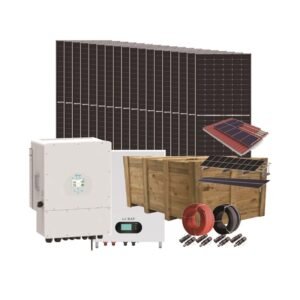Storing solar energy efficiently and affordably is crucial for maximizing the benefits of solar power systems, especially for times when the sun isn’t shining, such as nighttime or cloudy days.

Here are 10 relatively inexpensive ways to store solar energy:
1.Lead-Acid Batteries:
Lead-acid batteries are one of the oldest and most established technologies for storing solar energy. They are relatively inexpensive compared to other battery technologies, making them a popular choice for residential solar systems.
2.Lithium-Ion Batteries:
Lithium-ion batteries are becoming increasingly affordable due to advancements in technology and economies of scale. While they may have a higher upfront cost compared to lead-acid batteries, their longer lifespan and higher energy density can make them more cost-effective in the long run.
3.Flow Batteries:
Flow batteries store energy in liquid electrolytes contained in external tanks, allowing for scalability and potentially lower costs compared to traditional batteries. Vanadium redox flow batteries are one example of this technology.
4.Supercapacitors:
Supercapacitors can store and release energy quickly, making them suitable for short-term energy storage applications. While they are not as energy-dense as batteries, they can be cost-effective for certain use cases, such as smoothing out fluctuations in solar power output.
5.Pumped Hydro Storage:
Pumped hydro storage involves pumping water uphill to a reservoir when excess solar energy is available, then releasing it downhill through turbines to generate electricity when needed. While this method requires specific geographical conditions, it can be one of the cheapest ways to store large amounts of energy.
6.Compressed Air Energy Storage (CAES):
CAES systems store energy by compressing air into underground reservoirs or above-ground tanks. When electricity is needed, the compressed air is released and expanded through turbines to generate power. While CAES requires suitable geological formations, it can be a cost-effective storage solution.
7.Thermal Energy Storage:
Thermal energy storage systems store solar energy in the form of heat, which can then be used to generate electricity or provide heating and cooling. Phase change materials (PCMs) and molten salt are commonly used for this purpose due to their high energy density and relatively low cost.
8.Flywheel Energy Storage:
Flywheel energy storage systems store energy in the rotational motion of a spinning flywheel. When electricity is needed, the kinetic energy of the flywheel is converted back into electricity. While flywheels can be more expensive upfront, they have low maintenance costs and can provide fast response times.
9.Hydrogen Production:
Solar energy can be used to electrolyze water and produce hydrogen, which can then be stored and used in fuel cells to generate electricity when needed. While electrolysis can be energy-intensive, advancements in electrolyzer technology and decreasing renewable energy costs are making hydrogen storage more affordable.
10.Ice Storage:
Ice storage systems use excess solar energy to freeze water into ice during off-peak hours, which can then be used for cooling during peak hours. These systems are often used in conjunction with air conditioning systems and can help reduce energy costs by shifting cooling demand to times when solar power is abundant.
Each of these storage methods has its advantages and disadvantages, and the most suitable option depends on factors such as location, energy requirements, and budget constraints. Combining multiple storage technologies or integrating them with other renewable energy sources can further enhance reliability and cost-effectiveness.











